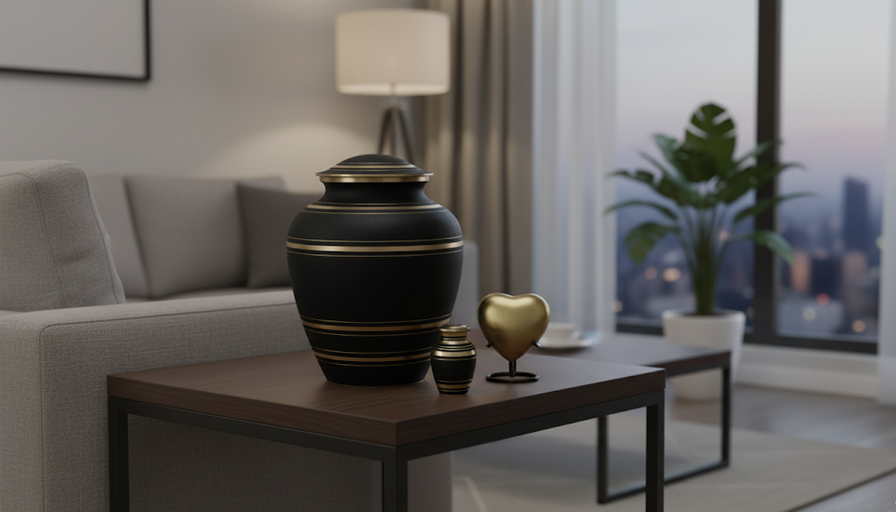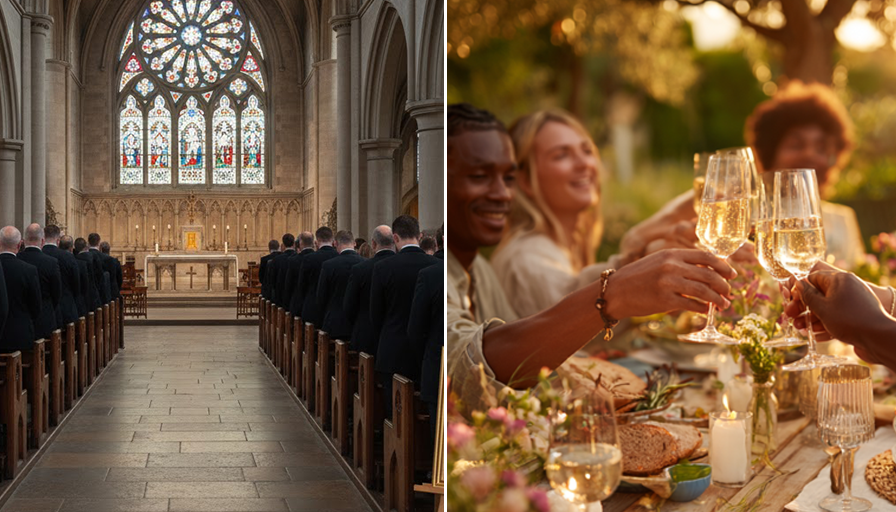Frequently Asked Questions about buying cremation urns, keepsake urns and companion urns - FAQ
Choosing an urn often raises many questions. That is completely understandable: buying an urn, keepsake or companion urn is not an everyday purchase, and it carries emotion and careful consideration. To help, we have answered the most common questions clearly and concisely, so you can quickly find reliable information about sizes, materials, personalisation, delivery and the law in the UK. Where helpful, we refer to related pages such as categories, guides and products.
-
What should I consider when buying an urn?
-
When is the right time to buy an urn?
-
What is the difference between an urn, a keepsake or mini urn and a companion urn?
-
How do I choose the right size?
-
Where can I place an urn?
-
Can an urn be placed outdoors?
-
Are there rules or laws around urns and ashes in the United Kingdom?
-
Can I personalise an urn?
-
How does ordering online work?
-
How quickly will I receive my order?
-
What if the urn does not meet my expectations?
-
Can I place the ashes into the urn myself?
-
Are keepsake- or mini urns suitable for children or pets?
-
Are companion (double) urns always large?
-
Are companion urns always large?
-
Are there environmentally friendly urns?
-
Can I order several mini urns at the same time?
-
Are all urns unique?
-
Can I view an urn in person first?
-
How discreet is delivery?
-
Are urns easy to clean?
-
How do I seal my urn?
-
Can I bury my urn?
-
Is my urn waterproof?
-
What happens if an urn arrives damaged?
-
Can an urn be opened later?
-
Is it possible to divide ashes among several urns or into jewellery?
-
How do I choose an urn that matches my loved one’s personality?
-
Are there urns combined with a tealight holder or photo frame?
-
What is the difference between standard urns and design urns?
-
How does shipping abroad work?
-
Can I send the urn directly to a crematorium or funeral director?
-
How much does an urn cost on average?
-
What types of urns are there?
-
Are there urns specifically for children?
-
Are there urns specifically for pets?
-
Can we divide the ashes among several relatives?
-
How long can I keep ashes in an urn?
-
Are there discreetly designed urns?
-
What is a columbarium?
-
Can I take an urn on an aeroplane?
-
What happens if the urn is knocked over or broken?
-
Can I choose a temporary urn?
-
Is it possible to commission a custom-designed urn?
-
How do I care for a bronze or metal urn?
-
Are there urns that combine a candle holder or photo frame?
-
How can I be sure the urn suits my interior?
-
Can I move the urn later?
What should I consider when buying an urn?
Focus on three things: the capacity (to match the amount of ashes), the material (suited to where the urn will be placed), and the design (aesthetics and symbolism). If you intend to keep all the ashes together, choose a full-size urn whose stated capacity matches the expected volume. For outdoor placement, select weather-resistant materials such as bronze, stainless steel, granite or natural stone; indoors, ceramics, glass and porcelain often look their best. Symbolism matters to many families. Hearts, teardrops and angels are common motifs, while minimalist designs offer a contemporary look. You can filter our range by material, colour, theme and intended use.
Background information:
On this page, you will find detailed information about what to consider when buying an urn.
Blog: How to choose the right urn size for your loved one
When is the right time to buy an urn?
There is no fixed moment. The right time is when you feel ready. Some families decide shortly after the cremation; others prefer to take more time. Both choices are perfectly valid. We are here to guide you at your own pace.
What is the difference between an urn, a keepsake or mini urn and a companion urn?
A standard cremation urn is designed to hold the full quantity of ashes of one person. A keepsake or mini urn holds a symbolic portion. Mini urns are also suitable for small keepsakes such as a lock of hair, a piece of fabric, sand from a favourite beach or soil from a grave. A companion urn holds the ashes of two people, often partners or spouses, so they can be commemorated together.
Background information:
- Here you can find more information about the different urn sizes
- A blog on mini urns as an alternative form of keeping ashes
- A blog explaining companion urns
How do I choose the right size?
As a general UK guide, the ashes from an adult cremation are usually around 3.0 to 3.5 litres or 183 to 213 cubic inches. The exact amount varies with body size and cremation factors (coffin dimensions, bone structure and any objects placed in the coffin). Keepsake urns typically range from 0.05 to 1.0 litre or 3 to 61 cubic inches for symbolic portions. Companion urns are usually 6 to 7 litres or 366 to 427 cubic inches in total. Each product page lists the capacity so you can select with confidence.
Background information:
- What size urn do I need? On this page, you can find detailed information about the different urn sizes, supported by our easy-to-use Urn Size Calculator to help you make the right choice.
Where can I place an urn?
You may keep an urn at home, place it outdoors in a suitable setting, or inter it in a columbarium or cemetery niche, depending on what feels right. Indoors, many families create a small remembrance space with photos and a candle. For gardens, select weather-resistant materials (bronze, natural stone, stainless steel). Our product pages indicate whether an urn is suitable for outdoor use so you can place it safely and durably.
Background information:
- A blog on how to display urns at home.
Can an urn be placed outdoors?
Yes, provided the urn is made for outdoor conditions. Bronze, granite, natural stone and stainless steel are durable and weather-resistant. Ceramics, porcelain or glass are generally intended for indoors unless the manufacturer states otherwise. Always check the specifications on the product page to avoid disappointment.
Background information:
- Blog on urns suitable for outdoor placement.
Are there rules or laws around urns and ashes in the United Kingdom?
Yes, but they are practical and designed to respect families’ wishes. In England and Wales, the cremation applicant instructs the crematorium what should happen to the ashes and may later amend those instructions in writing; crematoria must keep appropriate records and follow the procedures set out in the Cremation (Cremation (England and Wales) Regulations 2008).
In Scotland, the "Cremation (Scotland) Regulations 2019: guidance" provides the framework; scattering of ashes does not require a burial application, though local cemetery and crematorium rules still apply.
For scattering on land, obtain the landowner’s permission. For rivers and the sea, no licence is typically required, but follow Environment Agency guidance: avoid drinking-water intakes and sensitive locations (e.g., marinas, areas used by anglers), and do not leave items that may contain plastic or metal such as wreaths.
Background information:
- Blog: Is it Okay to Keep Cremation Ashes at Home?
- Blog: Burying Ashes in the Garden or other informal Settings
- Blog: Sustainable Farewells: A New Beginning for People and Nature
- Blog: Scattering Ashes and The Law
Can I personalise an urn?
Yes. Many urns can be personalised with names, dates or a short message. We also offer bespoke options in colour, form and design. Engraving, symbolic motifs or photo elements can add a deeply personal touch. Please allow for additional lead time for personalised or custom work.
Can I add engraving at a future date (after delivery)?
In most cases, yes. Additional engraving can usually be added later by our specialist partners or a local engraver. Simply contact us for advice on how to arrange it safely without damaging the urn’s finish.
If your urn does not meet your expectations, you can read more about adjustments or returns in our section What if the urn does not meet my expectations?
Background information:
- Blog: Can an Urn Be Personalised, Customised or Engraved?
- Page: Custom made Urns for Ashes, Cremation Jewellery and Monuments from scratch
How does ordering online work?
Simply choose your urn, add it to your basket and check out in our secure payment environment. We pack with great care and ship discreetly.
How quickly will I receive my order?
Many urns are in stock and dispatch within 5 to 10 working days. Personalised or bespoke items usually take longer. The product page always shows the current lead time.
What if the urn does not meet my expectations?
We offer a 100-day reflection period. If the urn is not right for you, please contact us. We will arrange a respectful and careful return process. (Custom or engraved items may have different terms; we explain these clearly in advance.)
Background information:
- Our page on exchanges and returns at legendURN.
Can I place the ashes into the urn myself?
Yes. Most urns have a secure screw or click closure that can be opened and closed carefully at home. If you prefer not to do this yourself, your crematorium or a funeral director can help. We can also provide basic filling guidance and a small funnel kit if needed.
Background information:
Are keepsake- or mini urns suitable for children or pets?
Yes. Keepsake or mini urns are often chosen for a small portion of a child’s or a beloved pet’s ashes. Their subtle size makes them intimate and easy to place. There are also dedicated designs for children and pets, with gentle forms and meaningful motifs.
Are companion (double) urns always large?
Not necessarily. Although they provide greater capacity, many companion urns are designed to remain visually compact and elegant, balancing function and aesthetic so they sit beautifully in the home.
Are there environmentally friendly urns?
Yes. Biodegradable urns are designed for burial in soil or water ceremonies, made from sustainable materials such as sand, salt or biodegradable paper. Please follow local environmental guidance, particularly for water settings.
Urns for Ashes
Background information:
- Biodegradable urns, specially designed to be returned to nature
- What is the Bios Tree urn? A Sustainable Way to Honour Your Loved One
Can I order several mini urns at the same time?
Yes. Many families choose to order multiple mini urns so each relative can keep a small, tangible remembrance. Matching sets are often available for a unified look.
Are all urns unique?
Many urns are handmade and therefore unique in finish and colour. Ceramics, glass and natural stone in particular show small variations that add character and a personal feel.
Can I view an urn in person first?
As an online retailer we generally cannot offer pre-purchase viewings; however, we provide detailed photos, videos and specifications, and offer personal advice by phone, chat or email. You can also order with confidence knowing you may return the item within our stated period (100 days) if it is not right for you.
How discreet is delivery?
Very discreet. We use plain, sturdy packaging. “Fragile” labels may be applied for safe handling, but the contents are not disclosed. Our packing process is careful and respectful.
Are urns easy to clean?
Yes, but care depends on the material. Dust ceramics and porcelain with a soft dry cloth; clean glass with a slightly damp cloth; treat bronze or metal with appropriate care products. Avoid aggressive cleaners and abrasives.
Background information:
How do I seal my urn?
Sealing your cremation urn properly is essential to ensure the ashes remain protected and undisturbed. Most urns are designed with a threaded lid or a discreet closure system that allows you to seal them securely. For extra peace of mind, you can use an acid-free silicone sealant or a specialist adhesive such as Polymax to make the closure airtight. If you prefer a symbolic gesture, some families add a ribbon, wax seal or personal inscription once the urn is closed. Always check the product details before sealing to confirm the best method for your chosen material.
Can I bury my urn?
Yes, many cremation urns are suitable for burial, either in a cemetery plot, memorial garden or private property where regulations allow. If you wish to return the ashes to nature, biodegradable urns made from materials such as sand, salt or paper pulp are ideal, as they naturally break down over time. For permanent burial, more durable materials such as bronze, stainless steel or stone are appropriate choices. Before proceeding, it is wise to check local cemetery or council rules to ensure the burial location is permitted and correctly registered.
Is my urn waterproof?
Whether an urn is waterproof depends on its material and design. Metal urns, such as those made of bronze or stainless steel, are typically weather-resistant and suitable for outdoor placement. Stone and marble urns can also withstand rain and moisture but may require occasional cleaning to maintain their appearance. Ceramic and wooden urns, on the other hand, are best kept indoors, as exposure to rain or frost can cause damage over time. If you wish to display an urn outdoors, always verify in the product description that it is specifically designed for outdoor or waterproof use.
What happens if an urn arrives damaged?
Please contact us immediately. We will provide a suitable solution, typically a replacement or repair handled swiftly and respectfully.
Can an urn be opened later?
Yes. Most urns can be reopened, for example to divide the ashes among relatives or to place a small portion into memorial jewellery. This should be done carefully; if in doubt, ask a professional to assist.
Background information:
Is it possible to divide ashes among several urns or into jewellery?
Yes. Many families keep a main urn at home or in a cemetery and share small portions in keepsake urns or memorial jewellery. Travel and scattering tubes are available if you plan to scatter at meaningful locations. We offer several solutions so you can honour a loved one in a way that feels personal and loving.
How do I choose an urn that matches my loved one’s personality?
Begin with feeling. Consider preferred colours, materials and symbolic forms that reflect the person, modern or classic; nature-inspired or minimalist; a favourite colour; a heart, butterfly or teardrop; or a companion urn for lifelong partners. Our filters by symbol and colour can help you narrow the selection, turning a practical choice into a personal expression.
Background information:
Are there urns combined with a tealight holder or photo frame?
Yes. Some urns integrate a tealight holder or a small photo window, creating a warm and personal remembrance space at home.
Background information:
- Categories for urns with tealight holders and urns with photo frames
What is the difference between standard urns and design urns?
Standard urns tend to be simpler and functional, prioritising value. Design urns are often artist-made pieces with distinctive forms, textures and finishes, resulting in unique works of memorial art.
How does shipping abroad work?
We ship internationally. Delivery times and costs vary by destination. All urns are packed robustly for safe transit. If you intend to carry ashes abroad yourself, please read the guidance under “Can I take an urn on an aeroplane?” below.
Can I send the urn directly to a crematorium or funeral director?
Yes. During checkout you can enter an alternative delivery address, such as that of a crematorium or funeral director, and inform them of the expected delivery.
How much does an urn cost on average?
Prices vary widely by material, size and design. Simple urns start at accessible price points, while artisan or one-of-a-kind designs can cost several hundred pounds or more. Keepsake urns are typically less expensive; companion urns are higher due to increased capacity and complexity. Our collection includes both affordable pieces and exclusive artworks, so you can find the right memorial for the person you are honouring.
Background information:
What types of urns are there?
There are full-size urns for keeping all the ashes, keepsake urns for symbolic portions, and companion urns for two people. There are also pet urns and memorial jewellery that holds a small amount of ashes. Common materials include bronze, ceramics, stainless steel, natural stone, glass, wood and biodegradable materials. Our category filters make it easy to browse by type and material.
Are there urns specifically for children?
Yes. These are smaller and often feature gentle colours and motifs lik estars, hearts, angels or animals, so the memorial feels tender and appropriate.
Background information:
- Category Baby Urns and Infant Urns
Are there urns specifically for pets?
Yes. Many families choose a small urn for a dog, cat or other companion animal. Pet urns are scaled accordingly and may feature pawprints or animal forms.
Can we divide the ashes among several relatives?
Yes. This is common and can be very meaningful. A typical approach is to keep a main urn and distribute small portions among keepsake- or mini urns or memorial jewellery, so several relatives can keep a personal remembrance.
How long can I keep ashes in an urn?
Indefinitely, provided the urn is well sealed and kept dry. Biodegradable urns are designed for temporary containment only, because they are meant to break down in soil or water.
Are there discreetly designed urns?
Yes. Many urns resemble a sculpture, a decorative object or a vase so their purpose is not obvious to visitors—ideal if you prefer a more private memorial.
What is a columbarium?
A columbarium is a structure of niches, typically at a cemetery or crematorium, where urns can be placed and sealed with an inscription plate. Local rules set the permitted sizes, materials and inscription formats.
Background information:
Can I take an urn on an aeroplane?
Many people wonder, “Can I travel with my urn?” or “Can I ship my urn?” Generally, yes. Airlines usually allow cremated remains to be carried in hand luggage, provided they are placed in a non-metal, X-ray-scannable container such as wood or a scatter tube. You should also carry the death certificate and the cremation certificate. If you plan to ship the urn, check the postal or courier regulations carefully, as each service may have different requirements. Always confirm your airline’s or carrier’s policy before travelling, as rules can vary between countries and companies.
Background information:
What happens if the urn is knocked over or broken?
Most urns have secure closures, and ashes should be kept inside an inner ashes bag placed within the urn. If the vessel is damaged, the bag helps to keep the contents safe. For outdoor placement, we advise not fixing an urn permanently with adhesive to a base, as it may need to be moved or accessed later.
Background information:
- Blog explaining why you should avoid gluing an outdoor urn to the ground
Can I choose a temporary urn?
Yes. Many families initially keep the ashes in the crematorium’s temporary container and select a permanent urn later. This allows time to consider the right form, material and symbolism.
Is it possible to commission a custom-designed urn?
Yes. We collaborate with artists and studios who can create fully bespoke urns. You can specify the form, colour and symbolism to reflect the person being remembered.
Background information:
How do I care for a bronze or metal urn?
Bronze and other metals can develop a natural patina over time, which many families appreciate. If you prefer a polished look, use suitable waxes or cloths and avoid harsh chemicals. Stainless steel typically needs only light cleaning with a soft cloth.
Background information:
Are there urns that combine a candle holder or photo frame?
Yes. Combination designs allow you to keep the ashes while also lighting a candle or displaying a photo, creating a warm focal point at home.
How can I be sure the urn suits my interior?
Choose by style, whether modern, classic or natural, and by colour palette. Neutral tones blend easily, while statement pieces can anchor a remembrance space. We can offer advice if you share a photo of the room where you plan to place the urn.
Can I move the urn later?
Yes. You may move an urn from home to a columbarium, a cemetery’s garden of remembrance or a family grave. Please note that cemeteries and crematoria will have local rules for interment and relocation, and you may need permission or an appointment.













